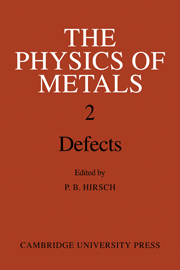1 - Point defects
Published online by Cambridge University Press: 04 August 2010
Summary
INTRODUCTION
In this chapter we shall mainly be concerned with point defects (vacancies and interstitials) in pure crystals, though substitutional and interstitial impurities will receive some attention, particularly as ideas originally developed to deal with them have subsequently been applied to vacancies and self-interstitials.
Section 1.2 is concerned with the formation of defects by thermal excitation, cold work and irradiation. Part of section 1.3 (on defect mobility) may appear a little out of proportion. However, it has seemed to the writer that many solid state and metallurgical texts introduce the standard jump frequency formula with much less discussion than they devote to related matters, and that therefore a slightly extended treatment at an intermediate level might be useful.
Section 1.4 (Physical properties of defects) is concerned with some of the basic physical properties (energy and volume of formation, effect on electrical resistance) of defects and their measurement. Since the presence of defects has usually to be inferrred from their influence on bulk properties this section could equally well be entitled ‘Effect of defects on physical properties’. It is perhaps best to confine this latter phrase to secondary effects consequent on the basic effects mentioned above. Important among them is the interaction between point defects and dislocations. Section 1.5 (‘Interaction energies of point defects’) serves as a link with other chapters.
- Type
- Chapter
- Information
- The Physics of Metals , pp. 1 - 42Publisher: Cambridge University PressPrint publication year: 1976
- 7
- Cited by



